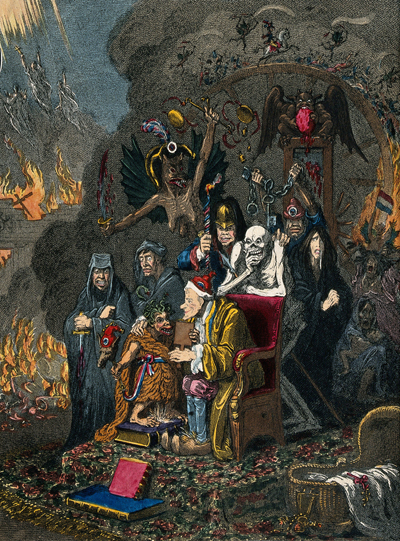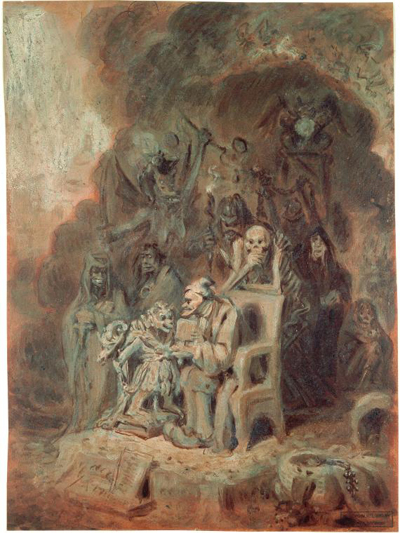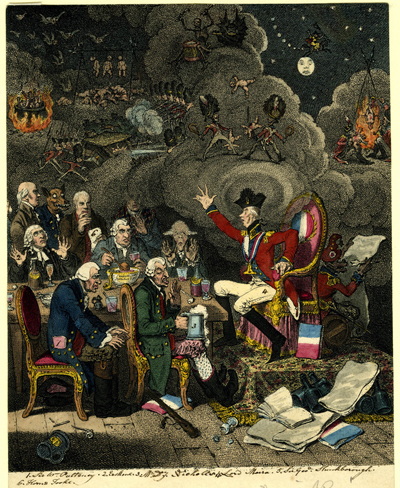[Ode to Jacobinism]
This is almost certainly a proof for a proposed but unpublished illustration designed to accompany the poetic parody, "Ode to Jacobinism," which appeared in the Anti-Jacobin, or, Weekly Examiner (without the illustration) on March 26, 1798. Supposedly authored by "An English Jacobin", and therefore representative of the goals and aims of French sympathizers, the poem begins by addressing itself to the mature Jacobinism.
Daughter of Hell, insatiate power,
Destroyer of the human race,
Whose iron scourge and madd'ning hour
Exalt the bad, the good debase;
Then, after reviewing her birth and tutelage in France and describing the results of her influence, the poem concludes by asking Jacobinism to bring similar perversion and devastation to England itself.

© Wellcome Collection
Most of the figures in the print can be readily identified from lines in the poem. In the center of the print, for instance, we see Jacobinism as a child. Her crib appears in the right hand corner. And as described in the poem, Voltaire is providing instruction.
VOLTAIRE inform'd thy infant mind;
Well-chosen nurse! his sophist lore
He bade thee many a year explore!
In the upper left, we see three figures fleeing from the fiery destruction of a city where a cross burns. They are the
. . .morals (antiquated brood);
Domestic Virtue, social Joy,
And Faith that has for ages stood.
Immediately surrounding Voltaire and the young Jacobinism, we find some of the other figures from the "Ode."
Revenge, in blood-stain'd robe array'd,
Immersed in gloomy joy profound;
Ingratitude, by guilt dismay'd,
With anxious eye wild glancing round. . .
With Death, thy victim's only friend,
Injustice, to the truth severe,
And Anguish, dropping still the life-consuming tear.
(I take it that Injustice is the hybrid monster with the bloody sword in one hand and the overturned scales of justice in the other.)
Other details more or less consistent with the poem can be seen behind and to the right of the two central figures, including
...thund'ring cannon, guillotine,
With screaming Horror's funeral cry,
Fire, Rapine, sword, and chains, and ghastly Poverty.
But Gillray adds figures such as the revolutionary soldiers on either side of death, the flesh-eating monster atop the guillotine, and most of the details characterizing the young Jacobinism that are NOT in the print.
This proof print would have been the logical next step after the preparatory sketch Voltaire Instructing the Infant Jacobinism in the New York Public Library collection. But before he finished, Gillray would likely have added book titles to the books at Voltaire's feet and some description on the paddle(?) in his hand. In his biography of Gillray, Mr. Gillray The Caricaturist Draper Hill long ago made the connection between the preparatory sketch and the Ode to Jacobinism in Anti-Jacobin, or, Weekly Examiner, but he seems to have been unaware that this print proof of the proposed illustration survived.

© New York Public Library
The proof no doubt derives from the preparatory sketch, but it also resembles in style, mood, and color another unfinished and unpublished print The Ode to Lord Moira which was also intended as an illustration and created around the same time (March 1798).

© Trustees of the British Museum
One reason why The Ode to Lord Moira never got beyond the proof stage was likely the inclusion of numerous caricature portraits in the print, which the Editors were trying to minimize in favor of generalized satire. That is obviously not an issue in Ode to Jacobinism. Why then was IT never finished or published?
We are unlikely to discover a definitive answer until we find more correspondence between Gillray and his employers at the Anti-Jacobin. But I think we can hazard a guess. In Gillray's best graphic satires, there is usually a controlling metaphor which unites the disparate elements of the print and enables us to "read it" at a glance. A good example is Britannia between Death and the Doctor's (May 20, 1804) where squabbles among Britannia's doctors put the health of her "constitution" in jeopardy, and where Pitt needs to kick out and step over her previous physicians to restrore her health. In the text of "Ode to Jacobinism," however, there is no controlling metaphor, but rather (as in most Odes) a direct address to a person or entity and a request for that entity to do something. Neither an invocation nor a request is something that is easily visualized.
As we have seen, Gillray has done his best to pick up whatever visual clues he could find in the poem, and incorporate them into his print. But lacking a controlling metaphor, he could not really unite the disparate elements into a coherent narrative. And that probably prevented it from being approved for final publication.
But though he may not have provided the kind of easily recognizable satire his editors may have hoped for, what he did provide was a detailed and phantasmagoric print that easily rivals the most visually romantic and fantastically inventive of Gillray's works.
Sources and Reading
- Draper Hill, Mr. Gillray The Caricaturist, 1965, p. 101 Pl. 83.
- "Anti-Jacobin," Wikipedia
- "Voltaire," Wikipedia
Comments & Corrections
NOTE: Comments and/or corrections are always appreciated. To make that easier, I have included a form below that you can use. I promise never to share any of the info provided without your express permission.